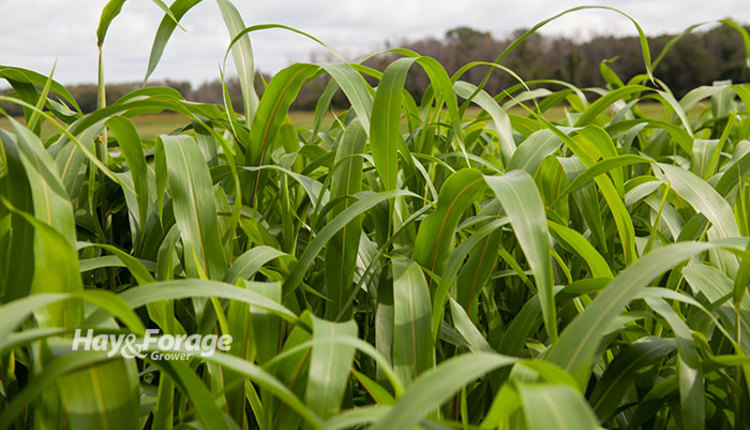
The Fourth of July can be a pivotal point on the calendar. After attending the highly anticipated parades and firework displays, it may feel like the dog days of summer are on a downward trend toward the fall. The next several weeks can be valuable from a forage production standpoint, though, especially regarding annual species.
Seeding annual forages on available acres in mid- to late July and August can bolster feed supplies for the months ahead. Mary Drewnoski and Daren Redfearn with the University of Nebraska Extension note species selection and planting date will depend on the intended use of the additional feed. The beef systems specialist and the forage and crop residue specialist categorize annual forages by their potential for hay production, silage production, fall grazing, and winter grazing, as well as when it is a prime time to plant them.
Hay production: Sorghum-sudangrass and pearl millet are two species that can yield adequate growth for fall hay production. The extension specialists state sorghum-sudangrass can produce 3 to 4 tons of dry matter per acre by mid-September if it is planted now, and pearl millet could yield 2 to 3 tons of dry matter per acre within the same time frame.
Hay quality will depend on plant maturity at harvest, which will be optimized when sorghum-sudangrass and pearl millet are between dough and boot stage. A timely cutting of these species can result in 55% to 65% total digestible nutrients (TDN) and 6% to 10% crude protein.
A third summer annual that is suitable for hay production is foxtail millet. Although this species will likely have lower yields than sorghum-sudangrass or pearl millet, it has other redeeming qualities that might make it a better fit for a farm. “Typical hay yields range from 1.5 to 2.5 tons of dry matter per acre, but it is earlier maturing and dries quickly,” the extension specialists state. “Seed cost is also usually less for foxtail millet,” they add.
Silage production: In addition to hay production, sorghum-sudangrass and pearl millet can also shine in the silage pile; however, forage sorghum might have a leg up on the competition in this category. This species can yield 4 to 6 tons of dry matter per acre. “It may be necessary to swath and then chop forage to get the correct moisture of 30% to 35%,” the extension specialists assert.
Forage sorghum can contain 60% to 65% TDN and about 7% to 8% crude protein if it is harvested at soft dough stage. Harvesting at this stage is also advised for farmers who lack kernel processing equipment.
Fall grazing: Sudangrass — not sorghum-sudangrass — is among the best annual species for late summer and fall grazing. “It has smaller stems and will regrow after the initial grazing, resulting in equal or better yields in a grazing situation,” the extension specialists explain. “Sudangrass also has less risk of prussic acid poisoning than sorghum-sudangrass.”
To avoid prussic acid poisoning altogether, opt for pearl millet in a pasture. This species does not produce prussic acid, and thus can be grazed during and immediately after a killing frost. Cattle grazing sudangrass, on the other hand, must be removed from forage before the first frost and not allowed access to the pasture until at least one week later.
For both sudangrass and pearl millet, begin grazing livestock when plants are 15 to 20 inches tall. Then, remove animals from the field when forage height is reduced to 6 to 8 inches. “If the goal is for late summer grazing, it may be advantageous to delay planting until mid- to late July to ensure plants are at the desired stage for grazing,” the extension specialists suggest. “If the growth is greater than 36 inches tall, harvesting it as hay or silage may be best since grazing cattle will trample the forage and result in waste and slow regrowth.”
Winter grazing: Before planting annual forages for winter grazing, determine what animals will be out on the pasture. For instance, dry cows that will calve in the spring require lower quality forage than lactating cattle. Sorghum-sudangrass and pearl millet can typically sustain the former class of livestock while producing relatively high yields.
The extension specialists recommend planting sorghum-sudangrass and pearl millet in mid-July and stockpiling forage before implementing a swath grazing approach. “Both sorghum-sudangrass and pearl millet can grow up to 5 or 6 feet tall,” they state. “Swath grazing makes forage allocation for these tall forages much easier and reduces waste. Essentially, this system involves cutting the forage and gathering it into a windrow or swath, which is then strip grazed.”
For cattle with higher nutrient demands, cool-season annuals like oats and spring triticale are more ideal for winter grazing. These winter sensitive species will produce more biomass than winter hardy crops like winter triticale or cereal rye. Aim to plant them in late July or August.
Brassicas can be mixed with oats and spring triticale as these crops are especially high in energy and crude protein. In fact, including nonimproved varieties of purple top turnip or rapeseed with oats and spring triticale is a cost-effective way to reduce seed costs and boost overall forage quality.
“Studies we conducted at the U.S. Meat Animal Research Center in Clay Center, Neb., have shown oat-brassica mixtures to have TDN levels in the 70% to 80% range with losses less than 5% into January,” the extension specialists note. “Crude protein of the brassicas is typically around 20% to 25%, and oats have 15% to 20% crude protein.”
No matter which harvest method is used, choose an annual forage species that is compatible with it. Doing so will optimize forage production and help to enhance animal performance.

